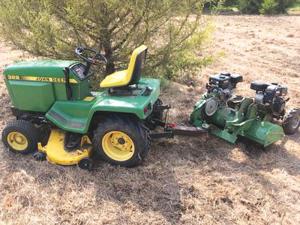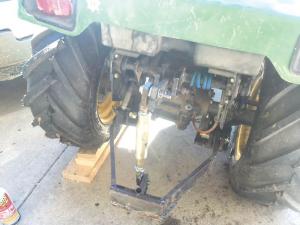Made-It-Myself Pull Behind “Super Tiller”
Brendan Compton of Augusta, Kan., built a twin-engine pull-behind super tiller. “It operates off of a ‘sleeve hitch’ or ‘integrated hitch’ (that I also built) for my Deere 322 garden tractor,” says Compton. “I use it for garden tilling and planting food plots for hunting.”
Compton first explored commercial tiller options but didn’t want to spend the money. “My dad had a couple of old rear tine tillers that he no longer needed,” he says. “This gave me the idea of building something that would fit behind the Deere 322. I had built a hitch to pull a plow behind the 322, so I designed the tiller to fit this hitch.”
Compton initially considered building a common shaft that would be run by a single engine, but he didn’t know how much power that would require. He wanted to stick to a design that could run on the equipment he already owned. “I opted to maintain two separate engines, two belts, and two tiller units,” he explains. “I thought if I hit a rock or something on one side, it would reduce the potential for damage to the tiller unit since it would only affect one side.”
Compton built the tiller for easy disassembly, maintenance, and design modification. The project took a lot of scrap metal. Most of his materials came from the two old tillers, although he estimates he spent $100 on a new Predator engine, $20 for gauge wheels (added later), and $50 in other metal and hardware.
“The tiller works great, he says. “I can till up virgin sod in a single pass. I control depth with a lever on the garden tractor, and I never have to deal with the struggles we’re all familiar with when running a rear tine tiller. It’s faster, smoother, less fatiguing, and significantly easier than a traditional walk behind tiller.” Initially, he found it difficult to control depth, but adding gauge wheels solved the problem and allowed it to roll over high spots. “The tiller is very maneuverable thanks to the Heim joint/pin on the long tongue,” he says. “The wheels on the back of the unit are two separate bogies, so it floats over uneven ground more smoothly.”
Compton sold his invention several years ago when he moved and needed larger equipment. To his knowledge, it’s still in use. “If I were building it again, I’d consider building it into a single unit with a single, larger engine for less maintenance.”
Contact: FARM SHOW Followup, Brendan Compton (ph 785-741-1310; brendancompton@hotmail.com).

Click here to download page story appeared in.
Click here to read entire issue
Made-It-Myself Pull Behind “Super Tiller” MOWERS Brendan Compton of Augusta Kan built a twin-engine pull-behind super tiller “It operates off of a ‘sleeve hitch’ or ‘integrated hitch’ that I also built for my Deere 322 garden tractor ” says Compton “I use it for garden tilling and planting food plots for hunting ” Compton first explored commercial tiller options but didn’t want to spend the money “My dad had a couple of old rear tine tillers that he no longer needed ” he says “This gave me the idea of building something that would fit behind the Deere 322 I had built a hitch to pull a plow behind the 322 so I designed the tiller to fit this hitch ” Compton initially considered building a common shaft that would be run by a single engine but he didn’t know how much power that would require He wanted to stick to a design that could run on the equipment he already owned “I opted to maintain two separate engines two belts and two tiller units ” he explains “I thought if I hit a rock or something on one side it would reduce the potential for damage to the tiller unit since it would only affect one side ” Compton built the tiller for easy disassembly maintenance and design modification The project took a lot of scrap metal Most of his materials came from the two old tillers although he estimates he spent $100 on a new Predator engine $20 for gauge wheels added later and $50 in other metal and hardware “The tiller works great he says “I can till up virgin sod in a single pass I control depth with a lever on the garden tractor and I never have to deal with the struggles we’re all familiar with when running a rear tine tiller It’s faster smoother less fatiguing and significantly easier than a traditional walk behind tiller ” Initially he found it difficult to control depth but adding gauge wheels solved the problem and allowed it to roll over high spots “The tiller is very maneuverable thanks to the Heim joint/pin on the long tongue ” he says “The wheels on the back of the unit are two separate bogies so it floats over uneven ground more smoothly ” Compton sold his invention several years ago when he moved and needed larger equipment To his knowledge it’s still in use “If I were building it again I’d consider building it into a single unit with a single larger engine for less maintenance ” Contact: FARM SHOW Followup Brendan Compton ph 785-741-1310; brendancompton@hotmail com
To read the rest of this story, download this issue below or click
here to register with your account number.








